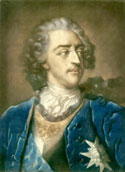The K in CMYK stands for “Key”, but don’t let anyone get away with that because it doesn’t answer the question; the answer is much more interesting than that. The “key plate” is said to add the “detail” to a printed image. This is true in that the black plate in a four color process print pushes the contrast and creates “detail”. Many people suggest that the theory of using K instead of B because it may be easily confused with “Blue” is a myth. While it is highly speculative what the reasoning is, there are context clues as to why it may actually be true.
The Myth…?
The story goes that old-style presses had only one color station, and must re-run material through the press for each color. After one color was laid down, the plate would need to be removed, the color station cleaned, the next color loaded, and so forth. This was very time consuming and individual print jobs would take days to finish. After a long day of printing, a press apprentice would begin loading the last color into the press: “B”. If any confusion occurred, the press could be loaded with blue ink, the entire job would need to started over, and the apprentice would most likely be beaten.
It seems natural that printers would want to use an alternative letter for black so this confusion could be avoided. The term “key” may be entirely pulled out of a hat.
The Context Clues
Mark Gatter, in the book he published titled “Getting it right in print”, states the “key plate” is used align the other plates, but does not mention why it is called “key”. While the term today may have adopted the meaning for the process of aligning plates, the term “key” does not originate from this process. The color “registration” is more closely related to the process of aligning plates. The term “key” originates from the rotary printing press in 1843 that had screw keys to control the amount of ink printing on a substrate. Offset presses also use this mechanism.
Most other countries who speak languages other than English typically used “CMYK” to mean four color process; even if the individual colors don’t begin with the same letters. However, in French speaking countries, the acronym is “CMJN” is used meaning “Cyan, Magenta, Jaune, Noir”. “Jaune” and “Noir” translate to “Yellow” and “Black” respectively. This shows that in certain countries, the model directly translates to “black” and not “key” or any other term referring to alignment, detail, or contrast.

While Johannes Gutenburg invented the printing press in Germany around 1454 which revolutionized moveable type, it was Jacob Christoph Le Blon who invented three-color and four-color process printing around 1725. What is interesting is that his original color models were RYB and RYBK. The argument here is that the color blue (represented by “B”) is used in the same process as black, so the initial may have been changed to avoid confusion. His three-color process would have used the same aligning technique as his four-color process, so if “key” was meant to mean “key plate”, it would theoretically have been the blue plate in his three-color model.
While it may never be known the exact origin of the use of “key”, it can be discerned that the myth could perhaps be true and that the origin of the term could have been to simply avoid confusion with the color blue. It appears the context clues may outweigh the notion that K is used to denote “detail” or “contrast”.


